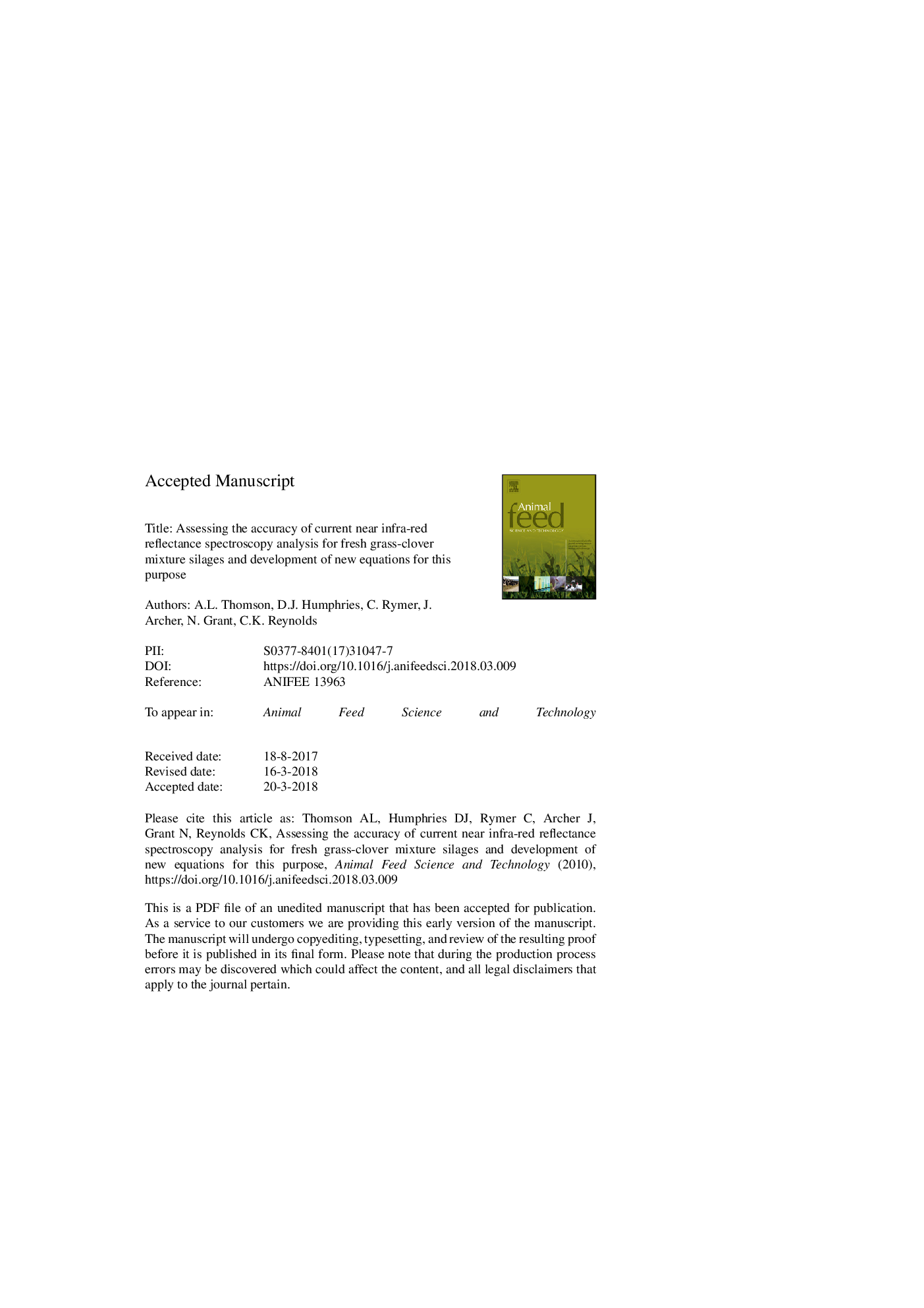| کد مقاله | کد نشریه | سال انتشار | مقاله انگلیسی | نسخه تمام متن |
|---|---|---|---|---|
| 8490976 | 1552347 | 2018 | 37 صفحه PDF | دانلود رایگان |
عنوان انگلیسی مقاله ISI
Assessing the accuracy of current near infra-red reflectance spectroscopy analysis for fresh grass-clover mixture silages and development of new equations for this purpose
ترجمه فارسی عنوان
ارزیابی صحت تجزیه و تحلیل طیف سنجی بازتابی در نزدیکی مادون قرمز برای سیلوهای مخلوط چمن و شبدر تازه و توسعه معادلات جدید برای این منظور
دانلود مقاله + سفارش ترجمه
دانلود مقاله ISI انگلیسی
رایگان برای ایرانیان
کلمات کلیدی
TMRMDMSEPNMSCEDNSECVTVCNIRSRPDWSCNH3-NRMSEPEDDMSECaNDFTVFAADFMixtures - مخلوط هاFIM - ENDAmmonia Nitrogen - آمونیاک نیتروژنLactic acid - اسید لاکتیکacid detergent fibre - الیاف پاک کننده اسیدstandard error of cross validation - خطای استاندارد اعتبارسنجی متقابلStandard error of prediction - خطای استاندارد پیش بینیStandard error of calibration - خطای استاندارد کالیبراسیونSilage - سیلوClover - شبدرNear infrared reflectance spectroscopy - طیف سنجی بازتابی مادون قرمزether extract - عصاره اترneutral detergent fibre - فیبر مواد شوینده خنثیorganic matter - ماده آلیwater soluble carbohydrate - محلول در آب کربوهیدراتNitrogen - نیتروژنCalibration - واسنجی یا کالیبراسیونcrude protein - پروتئین خامGrass - چمنTotal volatile fatty acids - کل اسیدهای چرب فرارtotal mixed ration - کل جیره مخلوط شده
موضوعات مرتبط
علوم زیستی و بیوفناوری
علوم کشاورزی و بیولوژیک
علوم دامی و جانورشناسی
چکیده انگلیسی
The purpose of this study was to ascertain whether Near Infra-Red Reflectance Spectroscopy (NIRS) prediction equations calibrated on grass silage samples, could accurately predict the chemical composition of mixed grass-clover silage samples, and furthermore, to develop and calibrate new grass-clover equations should the grass-based equations be insufficiently accurate for these silages. A set of 94 silage samples from mixed grass-clover swards (clover concentration (CC) ranging from 4 to 1000â¯g/kg as fed; determined manually) were analysed for chemical composition using reference laboratory techniques, in vivo digestible organic matter in the dry matter (DOMD, in sheep), and in situ degradability of dry matter and crude protein (in cows). The same samples were scanned fresh (undried and unmilled, as is standard practice for silage analysis within UK laboratories) using NIRS (at AFBI, Northern Ireland) and grass-based prediction equations applied. Predicted and observed results were compared. Of 15 chemical components that were tested for prediction accuracy, only volatile-corrected dry matter and nitrogen were well predicted (RPD values of 4.9 and 2.4 respectively, with low root mean square errors of prediction (RMSEP)). Neutral detergent fibre and DOMD showed low RPD values, however the predicted and observed datasets had no significant bias between them and were therefore also considered as fit for purpose. Variables with significant bias between predicted and observed datasets that were not considered suitably accurate included crude protein, acid detergent fibre, microbial dry matter yield and effective degradabile nitrogen. For many components, bias could be attributed at least in part to CC and changes in the fractionation of nutrients present. For some variables such as crude protein, grass-based equations were sufficiently accurate at low CCs but became inaccurate as CC increased, as expected. In response to inadequate prediction accuracy of certain nutrients, new grass-clover equations were calibrated using the obtained spectra. These were validated and results indicated that the grass-clover-based equations outperformed their grass-based counterparts. The adoption of new grass-clover equations, or alternatively, with further development, the use of a CC correction factor to the existing grass-based equations, is recommended for commercial laboratories offering undried and unmilled silage analysis on samples containing clover.
ناشر
Database: Elsevier - ScienceDirect (ساینس دایرکت)
Journal: Animal Feed Science and Technology - Volume 239, May 2018, Pages 94-106
Journal: Animal Feed Science and Technology - Volume 239, May 2018, Pages 94-106
نویسندگان
A.L. Thomson, D.J. Humphries, C. Rymer, J.E. Archer, N.W. Grant, C.K. Reynolds,
